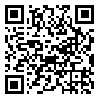Volume 5, Issue 3 (10-2014)
2014, 5(3): 133-146 |
Back to browse issues page
Young Researcher and Elite Club, Yasouj Branch, Islamic Azad University, Yasouj, Iran.
Abstract: (5938 Views)
Application of nitrogen sources in nutrient solution of soilless culture systems is one of the important factors in rose production. In order to investigate the effects of different ratios of nitrogen (N) source in nutrient solution on mineral concentration and vase life of rose (Rosa hybrid L. cv Dolcvita), an experiment was conducted as a randomized complete block design in a commercial greenhouse in Yasouj city with seven ratios of NO3-:NH+4:Urea (0:100:0, 50:50:0, 0:0:100, 50:0:50, 50:25:25, 70:15:15 and 100:0:0), three replications, and two observations per replication. Results showed that by increasing ammonium and urea in nutrient solution, concentration of macro elements such as N, P, K and Ca deceases sharply. The lowest Ca concentration was observed in plants fed with 0:100:0 NO3-: NH+4: Urea ratio. Higher ratios of nitrate in nutrient solution increased the amount of N, P, K and Ca. The amount of micro elements (Fe, Zn and Cu) showed a sharp decline by increasing ammonium and urea in nutrient solution. However, with an increase in nitrate concentration of nutrient solution, the concentration of micro elements increased. When the amount of urea increased in nutrition solution, vase life was reduced. The lowest vase life (11.1 days) was observed in plants fed with nutrient solution containing 0:0:100 NO3-: NH+4: Urea ratio. The highest vase life (17.6 days) was obtained in the solution containing 50:25:25 NO3: NH4+ : Urea ratio. In general, application of 70:15:15 or 50:25:25 NO3-: NH+4: Urea ratio for improvement of quantity and quality of rose flower, cv. Dolcvita, is recommended in soilless culture system.
Type of Study: Research |
Received: 2014/09/30 | Accepted: 2014/09/30 | Published: 2014/09/30
Received: 2014/09/30 | Accepted: 2014/09/30 | Published: 2014/09/30
Send email to the article author
| Rights and permissions | |
 |
This work is licensed under a Creative Commons Attribution-NonCommercial 4.0 International License. |






